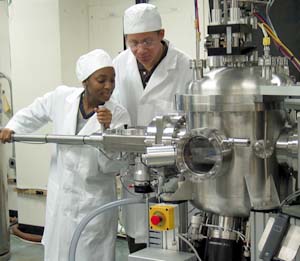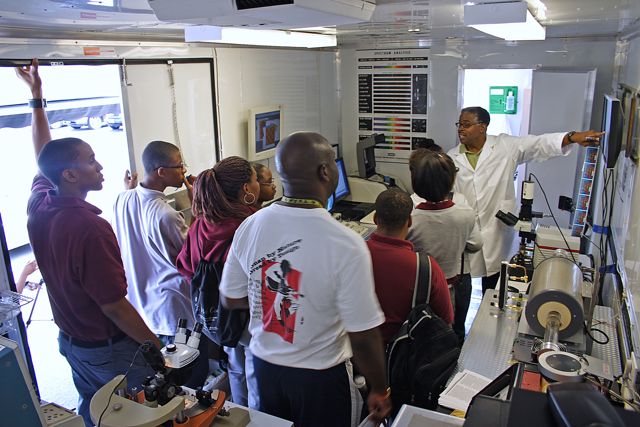Howard University
Howard Nanoscale Science and Engineering Facility (HNF)
Expertise: General Microfabrication, Electronics and Materials, Characterization Science, and Nanofiltration 
The Howard Nanoscale Science and Engineering Facility (HNF) routinely engaged in research and development in diverse areas such as electronics, materials science, optics, polymer science, membrane technology, medicine, physics and chemistry. In 2002, HNF supported 113 unique users. The breakdown includes 91 students, 31 women and 64 underrepresented minority students. We have identified three major technical areas where major contributions to the next phase of the overall USA effort in nanotechnology are available to the user. The three technical areas are Electronics and Materials (wide band gap devices and applications to nanotechnology), Chemistry (Characterization Science), and materials (nanofiltration membranes and technology). Numerous other instruments and techniques for nanofabrication and characterization have been developed.
Electronics and Materials (wide band gap devices and applications to nanotechnology): Unique electronic and optoelectronic characteristics of both, narrow bandgap group III-V and wide bandgap (these includes SiC and nitrides) materials can have profound effects on the tomorrows technology. Some topics areas that can be addressed for a complete realization of the potentials of these materials are: (1) Thin film epitaxial growth of nitrides and SiC; (2) Fundamental issues related to optical absorption, reflection and transport in materials and devices, (3) III-V-N based IR photodetectors (4) Group-III nitride based UV photodetectors (5) First-principle modeling of optoelectronic effects in group-III nitrides, and (6) Influence of defects on the performance of group-III nitride devices; (6) Group-III quantum wires and quantum dots. These research areas are coupled to the nature of NNIN and expertise in these areas will clearly advance nanotechnology and its application to real world problems
Chemistry (Characterization Science): Characterization Science is the universally required tool for advancing research and technology across the physical, biological, materials and medical sciences and engineering disciplines. Characterization science differs from characterizations. The latter is the practical application of well-established tools/methodologies by trained specialists including technicians to obtain information supporting other basic or applied research and development investigations. The former includes either the creation of concepts, development of new approaches, or innovative evolution of advanced techniques and methods, to enable the execution of chemical or physical characterizations. At research academic institutions, individual investigators usually have access to sophisticated characterization tools through facilities of the departments responsible for the discipline. Increasingly, investigations at the leading edge of research, involves multidisciplinary teams, where focused characterization science research is a key component of the overall effort. This input provides the team with essential information for evaluating new scientific phenomena, for innovating novel process technologies, and pioneering other technology developments. The synthesis of nanomaterials and the fabrication of nanotechnology devices present some of the most formidable and exciting challenges in chemical characterization science. Characterization research across a broad range of chemical regimes must underpin nanomaterials R&D.
Nanofiltration membranes and technology: Membrane processes such as reverse osmosis (RO), nanofiltration (NF), ultrafiltration (UF) and microfiltration (MF), have been used successfully in the fields of biotechnology, food science, chemical engineering, medical applications like artificial kidneys and more recently, environmental engineering for the separation and concentration of organic and inorganic materials. Pressure driven membrane processes have become an effective technique for the removal of environmentally undesirable and hazardous contaminants from aqueous systems such as natural water or wastewater streams.
Users can study the effect of membrane and pore charge on fouling and rejection by controlling the membrane charge by implanting permanent positively or negatively charged ions in the membrane skin. Low pressure NF, UF and MF membranes will be used. The role of pH, ionic strength, and the chemistry associated with this technology will also be examined.
NanoExpress
 “People can’t do what they can’t imagine”. The NanoExpress is about expanding the scientific imagination of people from K to Gray. The NanoExpress is a mobile science theme park exhibiting some of the latest science and technology at the nano dimension in a variety of disciplines. The NanoExpress is part of a major campaign designed to provide information on the current state of research and development in nanotechnology. It also aims to promote the dialogue between the world of science and the general public. What is nanotechnology? The study and applications of things or structures that are less than one hundred nanometers (1 nanometer = 10-9 meters or one-billionth of a meter) in size. Essentially this is the study of the “super small” (length scale comparisons: diameter of human hair ~ 100 µm or 100,000 nm).
“People can’t do what they can’t imagine”. The NanoExpress is about expanding the scientific imagination of people from K to Gray. The NanoExpress is a mobile science theme park exhibiting some of the latest science and technology at the nano dimension in a variety of disciplines. The NanoExpress is part of a major campaign designed to provide information on the current state of research and development in nanotechnology. It also aims to promote the dialogue between the world of science and the general public. What is nanotechnology? The study and applications of things or structures that are less than one hundred nanometers (1 nanometer = 10-9 meters or one-billionth of a meter) in size. Essentially this is the study of the “super small” (length scale comparisons: diameter of human hair ~ 100 µm or 100,000 nm).
Introduced in the summer of 2006, the NanoExpress is a mobile laboratory launched through the Howard University Nanoscale Science and Engineering Facility (HNF), The NanoExpress presents the complex, fascinating world of nanotechnology to the general public from K-Grey. The campaign was designed to provide information and training on the current state of research and development potential in nanotechnology. It also aims to promote the dialogue between the world of science and the general public.
The NanoExpress is a mobile van with 208 square feet of lab space designed to facilitate hands-on experiments, but is also capable of doing nanotechnology research. Undergraduate and graduate lab assistants help supervise experiments. The youngest visitor to date has been two weeks old and our oldest visitor has been 92. Experimental areas include: Introduction to Passive Nanoparticles, Introduction to Self Assembly, Introduction to Micro and Nanofabrication, “Chips are for Kids”, Instruments for NanoScience, Shape Memory Alloys and Soft Lithography.
We have a full schedule of events that include training, visits to elementary, junior middle, and senior high schools, national conferences, senior civilian civic clubs, Boy and Girls Scouts meetings, Lego Clubs, etc. The NanoExpress is also used by several advance level college courses.

For more information:
Howard Nanoscale Science and Engineering Facility web site
For further information contact:
James Griffin
Lab Manager
Howard University -HNF
2300 Sixth St #1124 NW
Washington, DC 20059
(202) 806-6618
griffin@mscre.howard.edu
